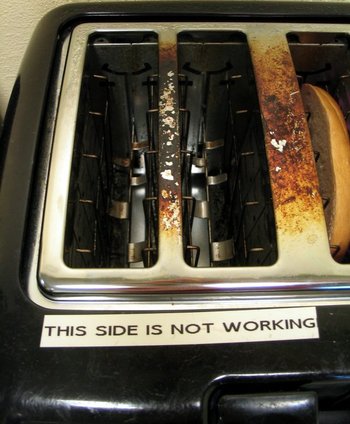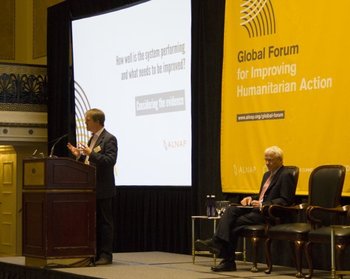More or less first thing this morning, my toaster stopped working. It wasn’t the fuse – I checked – and hitting it didn’t do any good. The bread sat there, stubbornly untoasted. No doubt about it: the toaster was broken.
In a parallel universe – one where I had listened when people explained basic electronics, and where built-in obsolescence wasn’t a feature of every electronic item – I would probably try to fix it. As it is, I’m just going to get rid of it. And such thoughts led me (as I’m sure they would lead you) to considering the World Humanitarian Summit, and the many discussions around our “broken” global system.
Of course, it’s a stretch. My toaster isn’t much like the disparate and changing set of organisations, laws, rules and financial flows that make up the ‘system’. But that’s the point. Toasters break, unequivocally. They have a fixed form and function and when one is damaged so the other can’t be achieved, we have three basic choices: live without it, try to fix it or throw it away and get another one. But social and political systems don’t break. They are not fixed in form, but changing and negotiated: some of the elements change, others stay the same, a few work well, others badly, some hardly at all. More than that, not everyone agrees on which bits of a system are ‘good’ and which ‘bad’.
So what do we mean when we say the humanitarian system is broken?
It’s hardly a diagnosis (or if it is, it’s a diagnosis based on a common but unhelpful metaphor of human systems as machines). But it is a very effective rhetorical device: a rallying cry for action that sounds conveniently like a diagnosis. And what is the nature of the proposed action? In this case, I don’t think that many people are proposing to fix the system – in the sense of putting it back just like it was before (When? Did it ever ‘work’?). By saying it is broken, we are implying that big, sweeping, root and branch changes are needed: throw it away and start again.
Options for changes fall into three broad categories: changes to the ‘how’ of humanitarian action; changes to the ‘what’ of humanitarian action; and changes to the ‘who’ of humanitarian action. So I started to wonder: How does the “broken” point of view see these types of change?
With some important exceptions (cash, ICT) there is only limited energy around changes to the ‘how’. I think this is partly because the ‘system’ has shown itself to be quite good at these sort of changes (Howls of protest, but what about cash? Clusters? Pooled funds? Assessments? Crowd-sourced data? Drones – I’m sure your time will come). It could do better, but it is worth remembering that international humanitarian action is a tiny sector, financially roughly equivalent to the global spend on chewing gum. There’s not a lot of money for R and D.
Just as importantly, these sorts of ‘technical’ changes don’t get much attention in the ‘broken’ discourse because they are not seen as radical enough to fundamentally change a ‘broken’ system. That’s a mistake. Technical solutions to clean water in urban emergencies, for example, could improve, even save, untold numbers of lives. More than that, the recent history of humanity has shown how technical change can drive societal change. In our own small sphere, the implications of cash might turn out to be as radical as any other WHS recommendation.
Changes to ‘what’ humanitarian action aims to do get more attention. They are perhaps radical enough to be good responses to ‘brokenness’. There are three problems here, though. Firstly, the formal system – as explored at the ALNAP Global Forum in June – is meant to be using a limited amount of money to fill a dizzying number of gaps: resilience, preparedness, provision of assistance and protection in the short term; long-term provision of basic services; urban crises and ‘mega’ health disasters. And in all of these contexts, all over the world, it is meant to meet needs, ‘build capacity’, ensure relevance – well, you know the list. Secondly, there are very real and honest disagreements over what should be the priorities among all of these things. And thirdly, the root causes of suffering lie far beyond the control of most of the actors sitting in WHS consultations. Questions about what humanitarian action should aim to do have been discussed as ‘broken’ problems, when in fact they are scoping problems. We should be calling for a focus on the scope and limits of humanitarian action (and to be fair, the WHS process has helped to clarify this, though it has not provided answers).
Which brings us to the changes around ‘who’ should be the principal actors in humanitarian response. This is perhaps the main underlying issue that has been discussed over the past months of the WHS. It’s the question of power. The ‘formal’ system – dominated by G20 donors and the United Nations, (predominantly ‘northern’) INGOs and the Red Cross and Red Crescent family, but with a very minor role for G77 governments and civil society – reflects the global distribution of power that existed over the period of its evolution. Yet the world has continued to change. Neo-liberalism, economic development in many states, and – for optimists – greater and more meaningful engagement of people in processes of power, all suggest that history hasn’t stopped, and that power continues to change and be negotiated. It’s not broken – it’s politics as usual. If the WHS process achieves anything, perhaps it is a clear consensus that in this political process, we all believe that the people affected by crises should have more of that power, and that as a sector we should make concrete changes to ensure that they do, and that ‘they’ (to the degree one can generalise about a very diverse group of people) can hold other powerful actors to account.
So “broken”, although it makes for a good soundbite, doesn’t really help define the problem. At ALNAP we believe that accurate, evidence-based diagnosis should be the starting point for change that works. We hope that the Global Forum and the recent State of the Humanitarian System contribute to this diagnosis, by pointing out the things that work and the things that don’t, and giving a problem definition that is a bit more comprehensive – and useful – than “broken”.
At the same time, while the WHS process – to date – may not be delivering what many people hoped, (a platform? Really? Is that all it was for?) it has at least made certain things very clear and very public. The primary role, and primary duty, in preventing and responding to humanitarian crises lies with states. Preventing humanitarian crises is about more than early warning, it is about building peaceful, prosperous and inclusive societies. Crises strike at the very roots of people’s individual and collective identities, and the process of responding to the crisis and rebuilding must place the people affected at the centre. The default for response should be local: affected state and civil society. The international ‘system’ should only ever fill gaps in this response. From here on in, we can probably agree that no points will be awarded for repeating these statements: it’s time to get on and do something.
Which brings me back to my now useless toaster. It’s broken, and I will do something – on the way home I’ll go and get another one, from the row of similar toasters displayed on the shelf of the shop on the high street. The “broken” analogy makes it tempting to go and get a new humanitarian system, too. But there’s no shop and no shelf. And unlike new toasters – which have been designed on the basis of old toasters and are tested and inspected – a wholly new system, created by fiat and magic wand, would not have been tested, would not necessarily be more successful than the current one, and might actually be worse. Which matters when the currency of success is human lives. Better to leave the rhetoric behind. We know (a lot of) what has to be done. Our energy should now go to the messy and difficult job of making real change in the real world.

